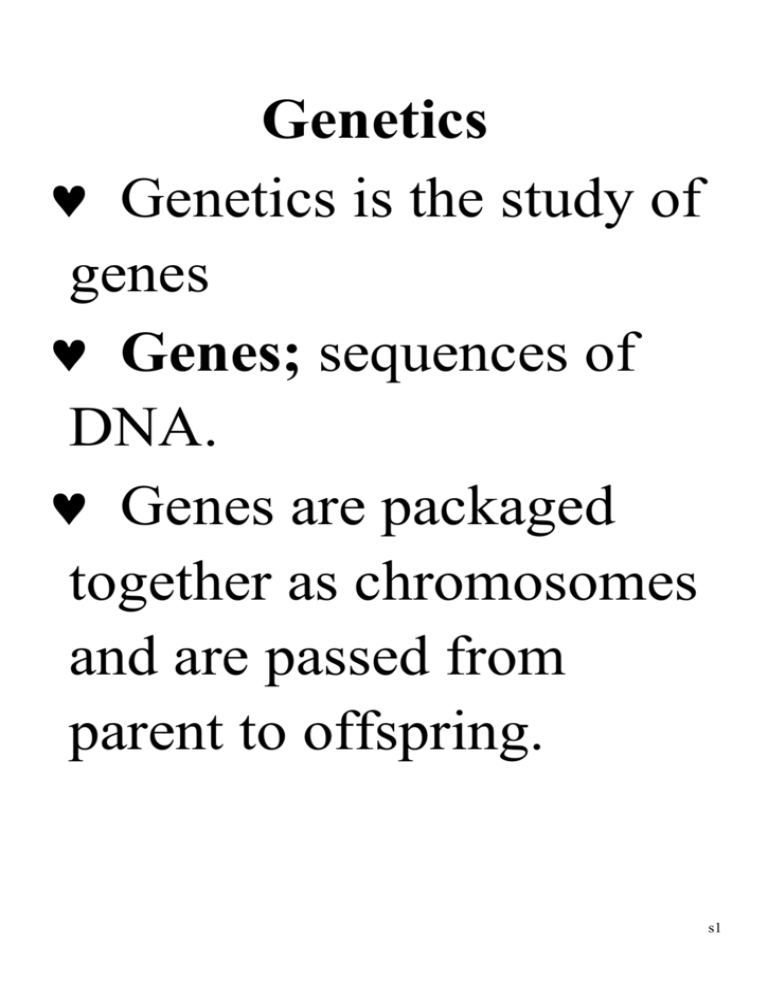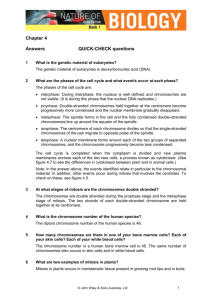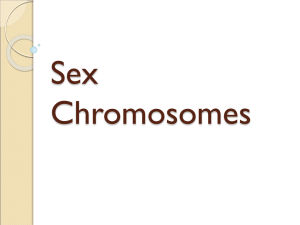Genes
advertisement

Genetics Genetics is the study of genes Genes; sequences of DNA. Genes are packaged together as chromosomes and are passed from parent to offspring. s1 It is our genes that determine who we are and how we function at the most basic cellular level. Sometimes mistakes (mutations) cause significant disability or death, or benefits. Genes; 25,000 genes. Chromosomes s2 Chromosomes are made up of molecules of DNA, complexed with proteins called histones. Chromosomes together carry the genetic blueprint of an individual. All human somatic (body) cells contain 23 pairs of s3 chromosomes, one pair from each parent, for a total of 46 chromosomes. Each human sex cell, an egg or a sperm, contains 23 unpaired chromosomes. Gene Activation s4 Although each somatic cell contains the same 23 pairs of chromosomes, only certain genes are activated in any given cell; therefore, only certain proteins or enzymes are produced by that cell. Which genes are activated in which cell is determined during embryologic development s5 and throughout life by circulating growth factors, hormones, and chemical produced by a given cell and its neighboring cells. Cellular Reproduction All cells reproduce during embryonic development, which allows for growth of the embryo and differentiation s6 (specialization) of the cells making up tissues and organs. After birth and throughout adulthood, many cells continue to reproduce. Cells that reproduce throughout a lifetime include cells of the bone marrow, skin, and digestive tract. Liver and kidney cells reproduce s7 when replacement of lost or destroyed cells is required. Special cells, called stem cells, are capable of reproducing indefinitely. Other cells, including nerve, skeletal muscle, and cardiac muscle cells, do not reproduce significantly after the first few months s8 following birth. Damage to these tissues generally cannot be repaired by growth of new cells . The Cell Cycle The cell cycle refers to a sequence of stages a cell goes through during its lifetime . During embryogenesis, all cells go through all stages, as do s9 adult cells that continue to reproduce. The rate at which a cell goes through its cell cycle depends on the given cell and the growth factors, hormones, and chemicals to which it is exposed. Cells that do not continue to reproduce after embryogenesis remain in a resting stage s10 and do not cycle through the other stages. The cell cycle is divided into two parts: interphase and mitosis. Interphase When not actively dividing, a cell is said to be in interphase. Mitosis s11 Mitosis is the stage of cell division. Mitosis is a shorter event than interphase; it lasts approximately 1 hour. During mitosis, the cell that has duplicated during interphase splits into two daughter cells that each contain the 23 pairs of chromosomes. Mitosis s12 consists of the substages of prophase, metaphase, anaphase, and telophase. Meiosis Meiosis is the process during which germ cells of the ovary (primary oocytes) or testicle (primary spermatocytes) give rise to mature eggs or sperm . Meiosis involves s13 DNA replication in the germ cell, followed by two cell divisions rather than one, which results in four daughter cells, each with 23 (unpaired) chromosomes. In males, all four daughter cells are viable and continue to differentiate into mature sperm. In females, only s14 one viable daughter cell (egg) is formed; the other three cells become nonfunctional polar bodies. During fertilization, genetic information contained in the 23 chromosomes of the egg joins with genetic information contained in the 23 chromosomes of the s15 sperm. This results in an embryo with 46 total chromosomes (two pairs of 23). An interesting phenomenon occurs during DNA replication in the first meiotic stage. At this time, pieces of DNA may shift between the matched chromosome pairs, in a s16 process called crossingover. Crossing-over increases the genetic variability of offspring, and is one reason why siblings within a family may vary considerably in genotype and phenotype. Genotype and Phenotype Precise genetic information carried in the s17 chromosomes of the offspring is termed the genotype. Physical representation of genetic information (tall or short, dark or light) is called the phenotype. Genetic Testing (cytogenetics) Genetic testing, called cytogenetics, involves s18 looking at the overall structure and number of the chromosomes. Genetic testing can be performed on any cell of the body, but in children and adults it is usually done by withdrawing white blood cells in a venous blood sample. For prenatal testing, fetal cells may be s19 gathered during the processes of amniocentesis, or during chorionic villi sampling. Amniocentesis Amniocentesis is performed by inserting a needle through the abdominal wall of a pregnant woman into the amniotic sac that surrounds s20 the fetus. Amniotic fluid, into which fetal cells have been shed, is withdrawn. Chromosomes present in the fluid sample are then cultured and fixed, and their number and shape are analyzed for genetic integrity. This test is usually done at approximately 16 weeks' s21 gestation and results are available in approximately 2 weeks. Chorionic Villi Sampling Chorionic villi sampling involves gathering cells of the chorion , the outer border of the fetal membranes. The cells are gathered by placing a needle through the s22 woman's lower abdomen or cervix between 8 and 12 weeks of pregnancy. The cells do not need to be cultured, so the chromosomal analysis is available in approximately 1 to 2 days.. Pathophysiologic Concepts Mutation s23 A mutation is an error in the DNA sequence. Mutations can occur spontaneously, or after the exposure of a cell to radiation, certain chemicals, or various viral agents. Most mutations will be identified and repaired by enzymes working in the s24 cell. If a mutation is not identified or repaired, or if the cell does not undergo programmed death, that mutation will be passed on in all subsequent cell divisions. Mutations may result in a cell becoming cancerous. Mutations in the gametes (the egg or sperm) may lead to s25 congenital defects in an offspring. congenital Defects Congenital defects, also called birth defects, include genotypic and phenotypic errors occurring during embryogenesis and fetal development. Some congenital defects, such as s26 cleft palate and limb abnormalities, may be apparent at birth, whereas other congenital defects, such as an abnormal or absent kidney and certain types of heart disease, may not be recognized immediately. Congenital defects may result from genetic mistakes made s27 during meiosis of the sperm or egg, or from environmental insults experienced by the fetus during gestation. Chromosomal Breaks During mitosis and meiosis, pieces of chromosomes may break off, be added inappropriately to other s28 chromosomes, or be deleted entirely. If deletions or additions occur during meiosis in the egg or sperm, a congenital defect or death of the embryo may result.. If deletions or additions of chromosomes occur during mitosis, the affected cell line will usually die out. s29 Errors in Chromosome Number Any change from the normal human chromosome number of 46 chromosomes is called aneuploidy. An aneuploidy in which there are only 45 chromosomes is called a monosomy. An aneuploidy in which there are 47 s30 chromosomes is called a trisomy. Having more than 47 chromosomes is possible but rare. Monosomy If any chromosome other than the X or Y is lost, the embryo will spontaneously abort. However, the loss of one of the sex chromosomes may result in s31 a viable offspring. Usually the Y chromosome is lost, resulting in 44 somatic chromosomes and one sex chromosome, for a total of 45 chromosomes (often expressed 45, X/O, to indicate no Y chromosome). The resulting disorder is called Turner's syndrome. s32 Monosomy of any chromosome is a major cause of spontaneous abortion in the first trimester. Trisomy A trisomy occurs when somatic or sex chromosomes do not separate properly during meiosis. This is called nons33 disjunction. Most trisomies cause spontaneous abortion of the embryo, but rarely live births may result. Trisomies that may result in live births include trisomies of the sex chromosomes and trisomies of chromosomes 8, 13, 18, and 21. Trisomy s34 21 is called Down syndrome. Teratogenesis Teratogenesis is an error in fetal development that results in a structural or functional deficit (e.g., a deficit in brain function). Environmental stimuli that cause congenital defects are called teratogenic s35 agents. Teratogenic agents can lead to genetic mutations or errors in phenotype. Common manifestations of teratogenic exposure include congenital heart disease, abnormal limb development, mental retardation, blindness, s36 hearing loss, and abnormalities in growth. Of the teratogenic agents : 1 - Alcohol The most common teratogenic drug used in the United States is alcohol. Alcohol at any dose is capable of causing neurologic deficits and s37 facial deformities ranging from mild to severe. Alcohol is the leading cause of birth defects and mental retardation; fetal alcohol syndrome. Fetal alcohol syndrome is 100% preventable. 2 - The TORCH Group of Teratogens s38 Several different microorganisms are known to be teratogenic in humans. Many of these are described under the acronym TORCH, in which each letter stands for a particular microorganism that may infect the embryo or fetus. s39 T stands for toxoplasmosis, R for rubella, C for cytomegalovirus, and H for the herpes simplex virus. The letter O stands for all other infections, especially syphilis, s40 hepatitis B, mumps, gonorrhea, and chickenpox. A newborn infected during gestation with any of the TORCH group of microorganisms may show microcephaly, hydrocephaly, mental retardation, or loss of hearing or sight. s41 Congenital heart defects are common, especially with rubella. 3 - Radiation exposure may increase the risk that the child will later develop cancer. *Whether an embryo or fetus will be affected by any teratogenic agent depends on several factors, s42 which include the timing and dose of exposure, and maternal and paternal health and nutritional status. Timing of Exposure to a Teratogen - Because most organs and tissues are formed during the first trimester, teratogenic agents are most s43 likely to cause structural defects at this time. - However, the nervous system is always susceptible to a teratogen because it continues to develop even after birth. - Infants exposed to an infectious agent in the third trimester or during the birth process are at s44 increased risk of developing the disease. This is true for neonatal infection by hepatitis B virus or HIV. Dose of a Teratogen - The dose of exposure is important in determining the likelihood that a teratogenic agent will cause a congenital defect. s45 - Levels of radiation used in most diagnostic techniques or low concentrations of a drug may not produce any effect on the fetus. - Higher doses of radiation or a drug may adversely affect the fetus. s46 Maternal Health and Nutritional Status This play a role in determining teratogen effect. Infants born to women with diabetes or seizure disorders are at higher risk of fetal anomalies, the latter perhaps due to the effects of both the seizures s47 themselves and the medications used to treat the disorder. Maternal diets low in folic acid have been associated with development of neural tube defects(NTD) such as spina bifida. s48 Down Syndrome Down syndrome is a genetic disorder caused by a trisomy of chromosome 21. Down syndrome is seen in 1 in 800 live births, s49 making it the most common chromosomal disorder seen in live births. In 95% of cases, Down syndrome is caused by non-disjunction of maternal chromosome number 21 during meiosis. The incidence of Down syndrome related to nons50 disjunction increases with maternal age. Clinical Manifestations - Variable levels of mental retardation. - Upward slanting of the eyes. - Short hands that have only one crease on the palm (a simian crease) - low-set ears. s51 - Short stature. - Protruding tongue. Complications - Congenital heart or other organ defects are frequent . - Risk of childhood leukemia is increased in s52 children with Down syndrome. - Spontaneously abortion of about 20% between 10 and 16 weeks' gestation. Turner syndrome Is a monosomy of the sex chromosomes. Infants born with Turner syndrome have 45 chromosomes: 22 s53 pairs of somatic chromosomes and 1 sex chromosome, usually the X (45, X/O). This disorder is common in spontaneously aborted fetuses, and is present in approximately 1 in 2,500 live births. s54 Females with Turner syndrome lack ovaries. Clinical Manifestations - Clinical manifestations may be nonexistent, mild, s55 or moderate and include: - Short stature and Webbing of the neck. - Lack of secondary sex characteristics and amenorrhea . Complications - Congenital heart defects may accompany the sex chromosome monosomy. s56 - Increased risk of childhood bone fractures and adult osteoporosis due to lack of estrogen. - Some individuals may demonstrate signs of learning disability. Klinefelter Syndrome Klinefelter syndrome is a polysomic disorder s57 characterized by one or more extra X chromosomes in a genotypic male (47, X/X/Y; 47, X/X/X/Y). This syndrome occurs in approximately 1 in 600 live births. Klinefelter syndrome may result from non-disjunction of the male or female X s58 chromosome during the first meiotic division, at approximately equal rates in males and females. Clinical Manifestations s59 Although the infant may appear normal at birth, he may show a decrease in male secondary sex characteristics during puberty. Gynecomastia (breast enlargement) and other female patterns of fat deposit. s60 Infertility and sexual dysfunction. Tall stature in adult life because decreased levels of testosterone do not contribute to epiphyseal bone plate closure. Individuals may demonstrate reduced mental functioning, especially with increasing s61 number of X chromosomes. s62









